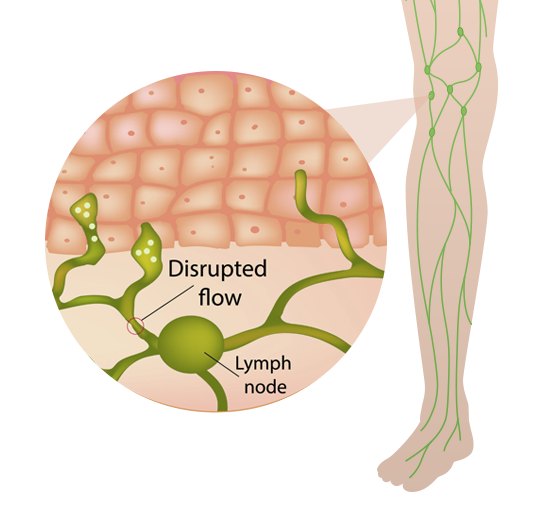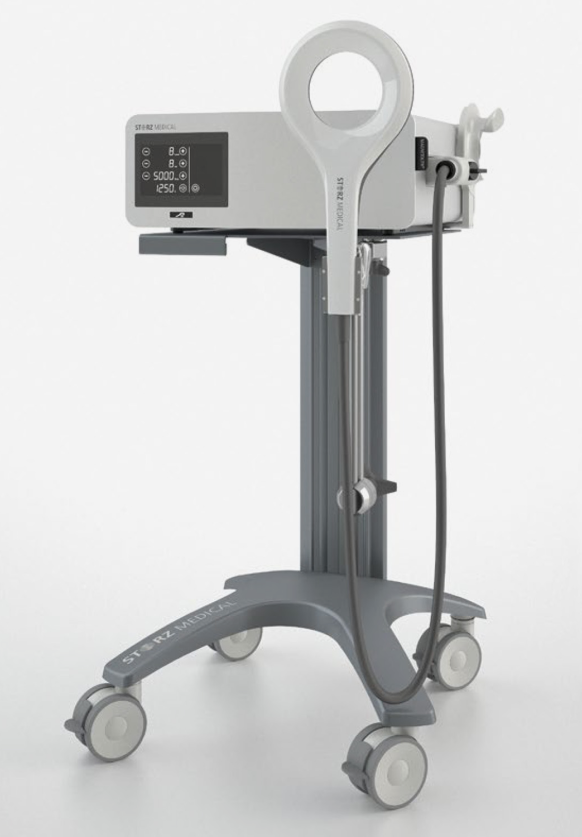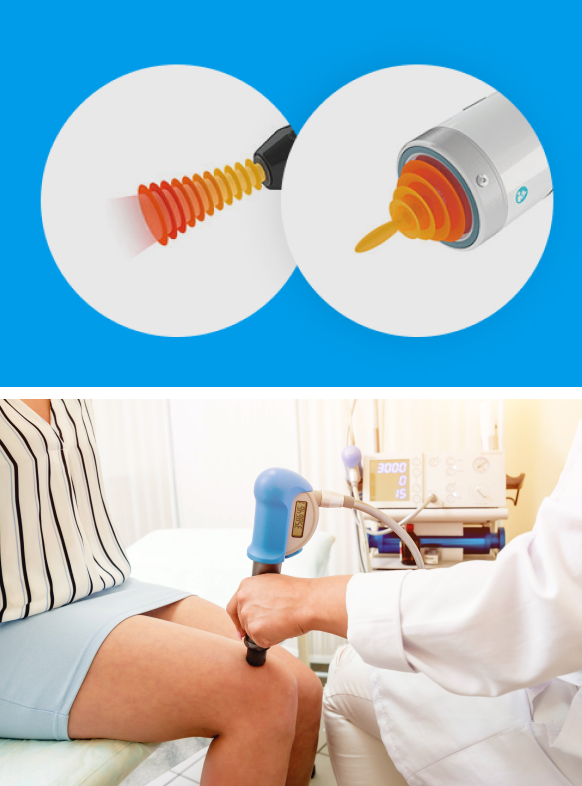The lymphatic system plays a key role in the body’s immune response. It mediates fluid levels in tissues throughout the body and flushes out waste and toxins from the cells. To operate at its best, lymphatic fluids must be able to flow through the lymph nodes and vessels of the lymphatic system without impedance.
When one or more lymph nodes or vessels becomes blocked or damaged, lymphatic fluid backs up and cannot be properly flushed from the body. The fluid builds up in tissues below the skin, mostly in the arms and legs, causing extreme swelling. In some cases, lymphedema causes fibrotic lesions in soft tissues that are difficult to break down with manual therapy.
Cancer and cancer treatments are two primary causes of lymphedema, according to the Centers for Disease Control and Prevention (CDC). Extracorporeal shockwave therapy (ESWT) is a breakthrough evidence-based technology for successful non-surgical lymphedema treatment.
or
NYDNRehab Clinical Director Dr. Lev Kalika is an expert in extracorporeal shockwave therapy (ESWT), with over 20 years of clinical experience. He has published multiple peer-reviewed research articles on ESWT and its applications, and he continues to expand his knowledge.
In addition to shockwave therapy, the clinic at NYDNRehab features INDIBA therapy, a type of radiofrequency therapy that helps to restore the ionic charge of damaged cells after cancer treatment. Dr. Kalika uses sonoelastography to navigate the lymph nodes, to evaluate fibrotic lymph tissue and target the zone for treatment.
Recent research has shown ESWT to be an effective treatment for lymphedema, superior to conventional Decongestive Lymphatic Therapy (DLT). NYDNRehab prides itself on providing patients with the very best non-invasive options for non-surgical lymphedema treatment in NYC.

Most physical therapy clinics take a one-size-fits-all approach to lymphedema treatment, not taking into account the unique characteristics and needs of individual patients. In many cases, treatment is only marginally effective, and patients despair of ever finding relief.
At NYDNRehab, we take a holistic and personalized approach to patient care, working one-on-one with each patient to get optimal results. Our track record of success in relieving the symptoms of lymphedema makes NYDNRehab the premiere clinic of choice for lymphedema physical therapy in NYC.
Pain, discomfort and tightness in the affected limb
Reduced function and range of motion
Thickening and/or hardening of the skin at the site of swelling
Skin infections
Swelling in the hands, arms, legs and neck
Cancer, especially of the breast, skin and reproductive organs post-surgery
Infections such as cellulitis or lymphatic filariasis (parasites)
Injury to lymph nodes or vessels
Radiation for cancer treatment
Scar tissue from injury to the lymphatic system
Surgery that removes lymph nodes for biopsy or cancer
Obesity
Sedentary lifestyle
Exposure to radiation
Chronic inflammation
Exposure to cancer-causing carcinogens
Following a thorough medical history and physical exam, we use the highest resolution diagnostic ultrasound to visualize the lymphatic system and affected tissues.
The progression of lymphedema occurs in four stages:
Reduced lymphatic flow with no external signs or symptoms
Fluid begins to accumulate and cause swelling that can be managed by limb elevation or massage
Fluid buildup causes swelling that will not go down
Elephantiasis sets in, with limb deformity, thickened skin, hardened growths and scarring.
Ultrasound lets us look below the surface to gauge the volume and extent of lymphatic buildup, locate fibrotic lesions in soft tissues, and identify the site of blockage in the lymphatic system.


When lymphatic tissue has been surgically removed, or when irreparable damage has been done to the lymphatic system, you may need ongoing care to manage lymphedema.
Unlike the cardiovascular system whose blood volume is circulated by the heart, the lymphatic system has no pump, and relies on muscle contraction to push the fluids into the lymph nodes for drainage.
The conventional approach for non-surgical lymphedema treatment is called Decongestive Lymphatic Therapy (DLT).
DLT has four fundamental components:
Wearing of compression garments and bandages, to manage swelling and prevent fluid buildup in soft tissues.
Integrated systems model (ISM) approach to assess how past injuries, faulty movement patterns and posture may be causing pain in your shoulder blade
Exercise that engages the muscles in the affected region to help push fluid into the lymph nodes for drainage.
Manual lymphatic drainage (MLD), a specialized type of massage therapy designed to help move excess fluids from your soft tissues into your lymph nodes for drainage.
While DLT can help you manage lymphatic fluid build up, it is important to note that it is ineffective for breaking down fibrotic lesions in the affected tissues.
Because of the nature and physiology of lymphedema, manual therapy is only marginally effective in reducing fluid buildup, and not effective at all in eliminating fibrotic lesions. But new award-winning research offers hope for patients suffering from lymphedema.
A 2020 study published in the Annals of Rehabilitation Medicine enrolled 30 female breast cancer patients with stage 2 lymphedema and divided them into two groups. The experimental group was treated with defocused extracorporeal shockwave therapy (ESWT) while the control group received conventional therapy.
After three weeks of treatment, the ESWT group showed significant improvement in arm circumference, fluid volume, rate of water content in the upper extremity, and skin thickness, with significantly higher scores on the QuickDASH (Quick Disabilities of the Arm, Shoulder and Hand) Questionnaire. ESWT was effective in treating fibrotic lesions that cannot be treated by DLT therapy alone.
Defocused shockwave is an evidence-based, ultra effective treatment approach for lymphedema that by far surpasses manual therapy.


INDIBA therapy is a type of transfer of energy capacitive and resistive (TECAR) therapy that helps to restore the ionic charge of cells damaged by cancer treatment. Using a radiofrequency of 448kHz, INDIBA technology generates three biological effects:
Biostimulation
Vascularisation
Hyperactivation
INDIBA therapy increases metabolic activity within cells, and improves blood flow to the cells for enhanced oxygenation. INDIBA stimulates the creation of new collagen, detoxifies tissues and supports lymphatic drainage.

Dr. Kalika has been treating patients with ESWT since its inception as a treatment tool for musculoskeletal rehabilitation. ESWT is a regenerative technology that stimulates cellular repair and tissue healing. It has a proven track record for successfully treating a broad range of overuse injuries and pain syndromes.
To treat lymphedema, Dr. Kalika applies a combination of focused, defocused and radial shock waves, using the highest resolution probe available to locate the most fibrotic areas. He then uses sonoelastography to evaluate the size and density of the fibrotic zone, to determine whether focused or defocused shock waves will be most effective. After delivering the most effective option, he uses radial shockwaves to move the lymphatic fluid toward the heart, to promote drainage. INDIBA therapy is used in conjunction with shockwave therapy to promote cell healing and enhance results.
Dr. Kalika was an early pioneer in introducing ESWT to patients in the US. His expertise and experience with ultrasonography, shock wave therapy, and INDIBA therapy make him the best specialist in NYC for non-surgical lymphedema treatment.
Lymphedema is one of cancer treatment’s worst side effects. If you are a cancer survivor with symptoms of lymphedema, ESWT offers hope for lasting relief. Contact NYDNRehab today, and see how non-surgical lymphedema treatment with ESWT can dramatically improve your overall health and quality of life.
Dr. Lev Kalika is a world-recognized expert in musculoskeletal medicine. with 20+ years of clinical experience in diagnostic musculoskeletal ultrasonography, rehabilitative sports medicine and conservative orthopedics. In addition to operating his clinical practice in Manhattan, he regularly publishes peer-reviewed research on ultrasound-guided therapies and procedures. He serves as a peer reviewer for Springer Nature.
Dr. Kalika is an esteemed member of multiple professional organizations, including: